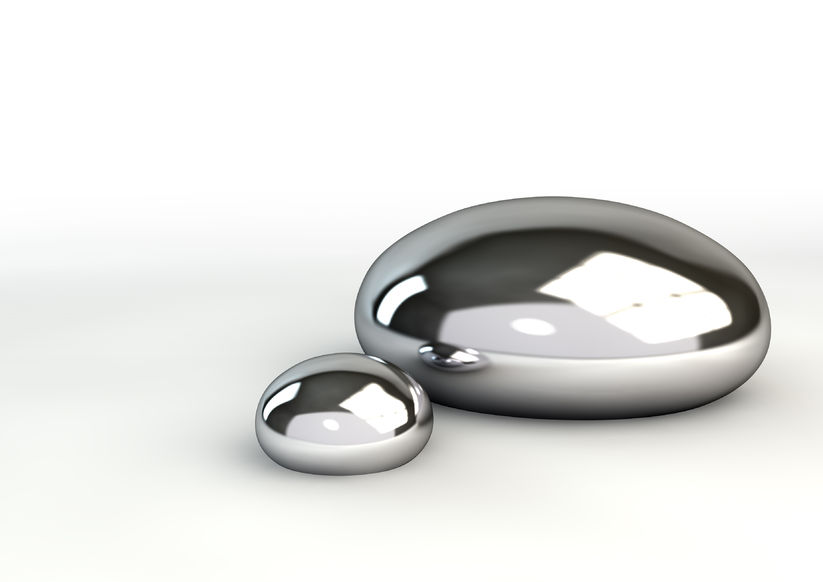 Margarita Milton
Margarita Milton
Nobody asked me to do it. Organizing the big closet in the hallway was my choice, motivated by the desire to find some hidden treasures among piles of decades-old glassware. I found, among other things: dozens of flasks with nonstandard neck sizes, dirty Vigreux columns, a 20,000-liter flask, 5-milliliter beakers (cute but useless), and a giant mortar—without the pestle. At one point, I reached over some boxes for the farthest corner, and my fingers clasped something long and thin. I figured it was a volumetric pipette (I had already found 50), but pulled out a broken mercury thermometer instead.
Elemental mercury is most toxic by inhalation. It’s only slightly volatile, but the danger becomes severe in closed spaces such as mercury mines—or closets. This thermometer was broken near the 60°C mark, and I doubt much mercury escaped through the narrow channel over the decades it spent in the closet. My university’s Environmental Health and Safety department has a mercury thermometer exchange program. I gave it to them, but never actually followed up on getting it replaced with one that’s alcohol-based. Oddly enough, this wasn’t my first experience with a broken mercury thermometer. Back when my cousin and I were kids, my cousin had a fever, and my grandmother checked his temperature with a mercury thermometer. My cousin broke it, of course, and my grandmother threw it in a canal. If you’re worried that there’s a contaminated canal in some nearby suburb, rest assured—my grandmother lived in Russia.
becomes severe in closed spaces such as mercury mines—or closets. This thermometer was broken near the 60°C mark, and I doubt much mercury escaped through the narrow channel over the decades it spent in the closet. My university’s Environmental Health and Safety department has a mercury thermometer exchange program. I gave it to them, but never actually followed up on getting it replaced with one that’s alcohol-based. Oddly enough, this wasn’t my first experience with a broken mercury thermometer. Back when my cousin and I were kids, my cousin had a fever, and my grandmother checked his temperature with a mercury thermometer. My cousin broke it, of course, and my grandmother threw it in a canal. If you’re worried that there’s a contaminated canal in some nearby suburb, rest assured—my grandmother lived in Russia.
The salts of mercury are more toxic than the metal and cause severe kidney damage. Organomercury is much more toxic and, unfortunately, common. Inorganic mercury from burning coal or volcanoes is methylated by soil bacteria to form the methylmercury cation. Methylmercury moves up the marine food chain (bioaccumulation), and has been a major health concern for populations dependent on fish. Dimethylmercury is incredibly toxic, and was the poison that killed Dartmouth professor Karen Wetterhahn in 1996. She was making an NMR standard, and a few drops spilled, penetrating her latex gloves. She succumbed to severe neurological effects several months later.
I asked a fellow graduate student who works with organomercury to provide some tips on handling the material. He mostly uses it in a glove box, which is a good level of protection, but some compounds, such as MeHgOH, are solutions in water. These are the protective measures he recommends if organomercury has to be used in a fume hood: always wear gloves, lab coat, and goggles; move slowly and deliberately; have a second person nearby when opening containers; tell other people in the lab that you will be working with organomercury; plan ahead and try to minimize the number of transfer steps (which decreases the chance of a mistake). He suggests that a reaction with dimethylmercury, if it absolutely must be done, should be quenched overnight with HCl, as it will form less toxic HgCl2 and CH4.
Elemental mercury, despite the warnings, fascinates people, and is seemingly easy for nonscientists to obtain, judging by the number of YouTube videos where people show off its density—or do strange things like put it in an hourglass. To avoid the risk of inhalation, some of these mercury activities appear to be done outside (nonscientists usually don’t have fume hoods), and people wear gloves, but they don’t seem too concerned about the health hazard. I would never suggest that elemental mercury is safe, nor that it should be toyed with for fun. But people wouldn’t be messing with a material that is seriously dangerous just to become internet famous ... right?
Quartzy is the world’s No. 1 lab management platform. We help scientists easily organize orders, manage inventory, and save money. We’re free and always will be. Visit Quartzy.com or reach out at info@quartzy.com.
Interested in writing for The Q? Send us an email!
Share this:

Margarita Milton
Margarita Milton grew up in New York City. She received her BS in Chemistry from Stony Brook University after working on the synthesis of aromatic belts in the lab of Nancy Goroff. She is currently a graduate student in the Nuckolls Lab at Columbia University, where she creates novel architectures involving perylene diimides. In her spare time, Margarita likes to read and write.
